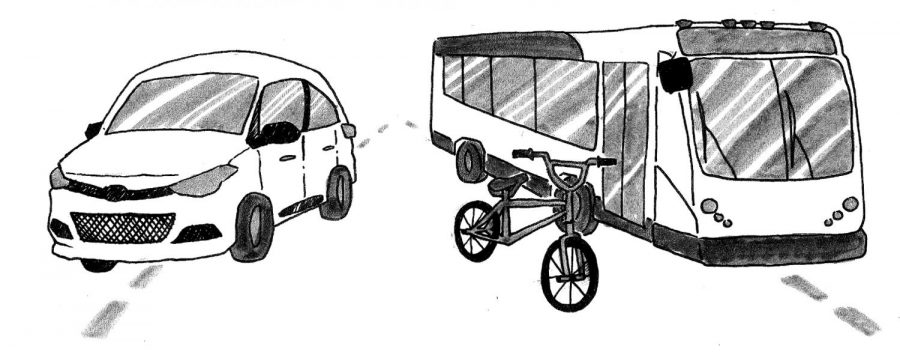Construct more parking spaces
Campus planning should reflect that people rely on driving themselves
ALONI MARTIN | The Daily Evergreen
Buses, bikes, automobiles and pedestrians — students, staff and faculty have a variety of options when making their way to campus every day, but as the university’s population rises and space becomes tight, will WSU invest in more parking lots, bike racks or buses?
October 19, 2017
Parking on campus has become a struggle affecting a large portion of the WSU community. The lack of parking options, especially on certain areas of campus, presents significant issues and wastes time, convenience and efficiency for people at the university.
Greg Yasinitsky, director of the WSU School of Music, said that in the last 30 years, parking options on campus have rapidly diminished, especially on the northwest side of campus near Bryan Hall and Colorado Street.
“There has been a methodical, obsessive program to eliminate parking,” Yasinitsky said.
Alternative ways of getting to campus, such as taking the bus or biking, are not reasonable for everyone. Yasinitsky pointed out that musicians often need to drive to campus because they have to transport their instruments and equipment.
“There is virtually no place to park that is near Kimbrough or Bryan Hall,” Yasinitsky said.
In addition to not working for many students and staff, public transportation on campus can be inconvenient and inconsistent, especially at late hours. Buses driving after 5 p.m. are few and far between. For those who work or study late, it can sometimes be difficult to get home.
At WSU, students and staff choose to have cars because they are the best method of transportation in rural eastern Washington. The university limiting vehicle accessibility to campus presents a major challenge.
Pullman is a city that truly experiences all four seasons. In the late winter, walking to campus becomes extremely difficult, and the buses are slower and much more crowded. Building more parking lots or garages, especially in areas of campus that do not currently have many parking options, would allow additional students and staff to safely commute to and from work or class.
Transportation Services Director John Shaheen said that the university is aware of parking shortages in specific areas on campus, and that they will work in the future to address these concerns.
“The most dramatic of these shortages are north of campus, near the residential areas,” Shaheen said.
Working to address parking shortcomings is a step in the right direction for Transportation Services. But a large reason why finding parking on campus can be difficult, Shaheen said, is due to the fact that the university keeps building new buildings on top of existing parking lots.
Yasinitsky said that when WSU develops new buildings, such as the Chinook Student Center, over parking lots not only makes it difficult to use these new facilities, but it hurts those who work in buildings nearby.
Building parking spaces isn’t cheap, and it is important to keep in mind that Transportation Services is self-funded, meaning they do not receive money from WSU. But that does not mean that the university can simply forget about the many students, staff and faculty that use parking and remove existing lots at their expense. Expecting everyone at WSU to go to and from campus without the use of cars simply isn’t realistic, and it is important that the administration remain aware of the community’s needs.





















